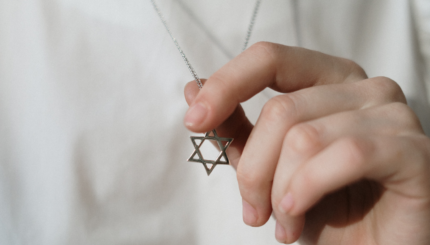There are many myths about conversion. The most pervasive is that rabbis must turn away potential converts three times before accepting them. But another is about how the process is supposed to unfold: You feel a stirring of curiosity, take a spiritually and intellectually fulfilling class, and finally — in some grand culmination — feel ready to take the plunge.
In reality, conversion candidates often struggle with what it means to feel “ready.” And while a new religious identity should never be taken on impulsively or haphazardly, waiting to feel fully ready can itself be harmful.
Conversion students may find themselves waiting for an “aha” moment that may never come or be comparing themselves to an external standard of religious understanding and behavior. Do I know enough? Is my practice at this moment where I want it to be forever? While these questions rattle around in the heads of many Jews, they can function as barriers to prospective converts who expect themselves to have clear answers and find themselves coming up short.
To be sure, Judaism does have expectations of prospective converts. But these expectations are less rigid than one might think.
With your help, My Jewish Learning can provide endless opportunities for learning, connection and discovery.
The foundational text outlining the ancient rabbinic conversion process (Babylonian Talmud, Yevamot 47) imagines a Jewish court responding to a prospective convert with only two questions: What made you want to convert? And do you know that Jews are oppressed, despised and harassed? If the prospective convert answers satisfactorily, then the court — in the Talmud’s words — “accepts the convert immediately.”
Upon acceptance, there is some minimal education given. The court is to inform the convert of “some of the lenient commandments and some of the stringent ones.” (The Talmud singles out the commandment to feed the poor through the mechanisms of gleaning, forgotten sheaves and tithed corners of a field.) And of the punishments and rewards of observing mitzvot like kashrut and Shabbat.
But the main feeling of this experience is captured in the Talmud’s summary: “The judges do not overwhelm the student [with too much information], nor are they exacting about the minute details.” So long as the convert accepts these overarching principles, the court performs the required rites — mikveh immersion and circumcision (when appropriate) — after which time the convert is accepted as a Jew in all respects.
From this passage it becomes clear that there are a few things converts should feel and a few things they should know.
The main qualifying criteria for conversion is a desire to convert and a sense that the convert’s fate is bound up with the fate of the Jewish people. There doesn’t seem to be a right or wrong answer to the court’s first question, but being honest and reflective seems paramount. The second question asks potential converts if they are willing to throw their lot in with a people whose history is littered with discrimination and persecution. Before converting, the tradition expects this question to be answered with a yes.
There are also a few things the Talmud expects the convert to know before the conversion.
They should know that Judaism requires a commitment to those who are needy and vulnerable (It is no surprise that the first mitzvot converts learn are those aimed at alleviating poverty and hunger). They should know how individual practices and mitzvot fit into a bigger religious project – that Jewish living can give tangible shape to some of life’s biggest questions or most deeply held beliefs. And they should know that Judaism is lived through our bodies and our actions. Conversion is enacted through immersion in a mikveh and circumcision (when appropriate); we mark internal, spiritual change through external, physical processes as a recognition that we are called to manifest our religious beliefs and ideas through real action in the world.
According to the Talmud — and affirmed in later legal writings — that is all that one needs to convert. The Talmud does not require a convert to fully believe. Conversion is not about having completely mastered and answered complex theological dilemmas and questions. It’s not about knowing with certainty why bad things happen to good people or how God operates in the world. It’s sufficient simply to know that Judaism offers a tradition that has struggled with these questions for centuries.
The Talmud also does not require full Jewish practice. Nowhere is there an expectation that one is fully observant at the moment of conversion. Indeed, the court is only to teach about “some” of the mitzvot, presumably with the acknowledgement that there will always be room for growth and change in one’s religious life. Conversion is one moment in what will hopefully be a long journey that will inevitably have many twists and turns. The tradition imagines the mikveh like a birth, complete with the expectation that there will be many opportunities for growing — and growing pains — in the future.
All of which is to say, when thinking about when to convert, there’s no need to wait to be fully ready. In fact, prospective converts may never get to such a point. Part of why Jewish tradition is so emphatic about accepting prospective converts “immediately” is because waiting has the potential to create an elusive standard of readiness that might never be achieved.
Rather, the Talmud suggests capitalizing on a moment of excitement, general insight and overall understanding to cross the threshold. The gaps can be filled in later on.
The medieval philosopher Maimonides imagines that converts are reenacting the process of the ancient Israelites when they first entered into that covenant at Mount Sinai. This comparison calls to mind the idea of na’aseh v’nishma — that at the moment of divine revelation, the ancient Israelites did not demand to know the full details of the Torah and all that it entailed. Rather, they accepted first, and agreed to study, learn and do later.
We make this same offer to those converting now. Join us — be a part of our people’s past and stake a claim to our collective future. You might never be fully “ready.” But part of this covenant is about taking a leap of faith into a community waiting to catch you and eager to welcome, support and grow alongside you.
Rabbi Sarah Krinsky is the assistant rabbi at Adas Israel Congregation in Washington, D.C.
Are you considering conversion to Judaism? Sign up here for a special email series that will guide you through everything you need to know.



